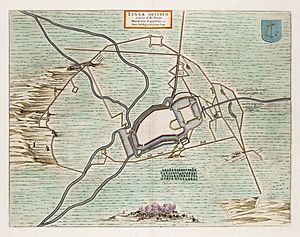Siege of Lingen (1597) facts for kids
Quick facts for kids Siege of Lingen (1597) |
|||||||
|---|---|---|---|---|---|---|---|
| Part of the Eighty Years' War and the Anglo–Spanish War | |||||||
 Siege of Lingen in 1597 from the Atlas Van Loon |
|||||||
|
|||||||
| Belligerents | |||||||
| Commanders and leaders | |||||||
| Strength | |||||||
| 6,000 infantry & cavalry | 500 | ||||||
| Casualties and losses | |||||||
| Unknown | All captured | ||||||
The Siege of Lingen was an important event during two big wars: the Eighty Years' War and the Anglo–Spanish War. It happened in 1597. A Dutch and English army, led by Maurice of Orange, attacked the city of Lingen.
The city was defended by Frederik van den Bergh and his soldiers, who fought for Philip II of Spain. The siege started on October 25, 1597. After more than two weeks, Van den Bergh gave up on November 12, 1597. This victory was a key part of Maurice's very successful military actions in 1597.
Contents
What Led to the Siege?
Prince Maurice of Orange had a great year in 1597. It began with a big win at the Battle of Turnhout. After that, he started a campaign in the summer. He moved through the eastern parts of the Netherlands. During this time, he captured important strongholds from the Spanish. These included cities like Oldenzaal and Groenlo.
Maurice's campaign was almost finished. Only Lingen was still controlled by the Spanish. By taking Lingen, the Spanish would have to leave the entire Twente region. Lingen was located at the edge of the Low Countries, which is now part of Germany. Frederik van den Bergh governed the town. He had about 500 soldiers defending it.
Maurice's Army Prepares
Maurice's army included soldiers from England and Scotland. They were led by Horace Vere. The army had just captured Oldenzaal. They then had to cross the Ems river, which they did without any problems. Horace's brother, Francis Vere, was a general for Elizabeth I in the Netherlands.
Heavy cannons were brought to Lingen by ship. They traveled through the Wadden Sea and then up the Ems river. This caused a few days of delay. But once these large guns were ready, they could fire on the city's defenses.
The Siege and Its Outcome
When the siege began, the soldiers defending Lingen tried to attack. They quickly burned a mill outside the city. However, the English and Scottish soldiers pushed them back. It took a lot of effort to set up the big cannons by the canal. This was needed to properly surround the city.
Soon, the cannons were firing. They heavily pounded the city's strong walls. The situation inside Lingen became very difficult. Van den Bergh hoped for news that another Spanish army was coming to help. But the only message he got from Cardinal Archduke Albert was to try and save the city himself.
With no hope of help, Van den Bergh surrendered Lingen to Maurice. This happened on November 12.
After the Victory
By capturing Lingen, Maurice completed his campaign of 1597. This was one of his many wins during a successful time. This period was known as the Ten Glory Years. As expected, the Spanish left the Twente region. Military actions for the year then ended.
Maurice had captured nine strong cities and five castles. He also made it safe to travel on the Rhine river. His victories greatly strengthened the eastern defenses of the Dutch Republic.
Lingen was later recaptured eight years later. This happened in 1605 by Ambrosio Spinola.
See also
- List of stadtholders in the Low Countries
- List of governors of the Spanish Netherlands
- Siege of Bredevoort (1597)
- Siege of Groenlo (1597)

